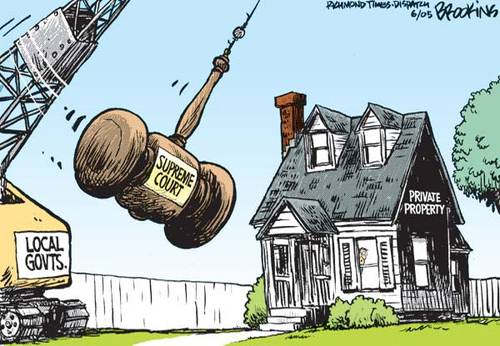In this article
If an investor is required to relinquish their property through a "forced conversion," the IRS provides an opportunity to defer capital gains taxes through the exercise of a 1033 exchange. Forced conversion occurs when a taxpayer's property is reclaimed by eminent domain, condemned, or disposed of under threat of condemnation by a government or a quasi- government agency and the taxpayer receives payment in the form of money, other property, or a condemnation award. Forced conversion also applies when a taxpayer's property is destroyed by a natural disaster and insurance proceeds are received. Fortunately, if an investor facing forced conversion follows the guidelines set forth in section 1033 of the Internal Revenue Code, they are able to complete a successful exchange and defer all of their capital gains taxes.
Without the special provision of the IRS, if an investor has any capital gains or depreciation recapture on the proceeds received from a forced conversion, they would have to pay taxes on the capital gains and depreciation in the same year they received the proceeds. This could exceed 20-30% of an investor's proceeds received from the conversion. However, if an investor utilizes the provisions set forth in the 1033 exchange, both capital gains and depreciation recapture taxes can be fully deferred, allowing an investor the potential to maintain and continue to build wealth despite the forced conversion.
1033 Qualification Guidelines
 Similar to a 1031 exchange, 1033 guidelines require an investor to reinvest proceeds from a forced conversion into a like-kind real estate exchange to qualify for full tax- deferment benefits. However, the tax deferral provisions and timelines of a 1033 exchange are typically much more relaxed and generous to the taxpayer than the 1031 rules and stipulations. In general, an investor seeking to complete a successful 1033 transaction should understand the type and value of assets that qualify for exchange and the timelines involved in completing an exchange.
Similar to a 1031 exchange, 1033 guidelines require an investor to reinvest proceeds from a forced conversion into a like-kind real estate exchange to qualify for full tax- deferment benefits. However, the tax deferral provisions and timelines of a 1033 exchange are typically much more relaxed and generous to the taxpayer than the 1031 rules and stipulations. In general, an investor seeking to complete a successful 1033 transaction should understand the type and value of assets that qualify for exchange and the timelines involved in completing an exchange.
1033 Exchange Asset Requirements: As with a 1031 exchange, a 1033 exchange is completed most often with a reinvestment of the forced conversion proceeds into "like-kind" investment real estate. "Like-kind" simply denotes that investment real estate must be exchanged for investment real estate. Personal residences and vacation homes that are not utilized primarily as rentals are not "like-kind" to investment real estate and do not qualify for a 1033 exchange. Though it is not as common, an investor in a 1033 exchange has other options in addition to "like-kind" real estate and even is allowed to select 80% control of a corporation owning replacement property to complete a successful exchange.
1033 Exchange Timelines: Whereas a 1031 exchange requires an investor to identify and close on replacement property within 45 and 180 days, respectively, from the close of the relinquished property, the 1033 exchange typically gives clients anywhere from two to three years from the date of the eminent domain or other forced conversion to close on replacement, like-kind real estate to complete the exchange. Section 1033 does not have any identification requirements, which allows the investor to select any number or combination of assets to complete a 1033 exchange. In order for a 1033 exchange to be considered complete, an actual purchase must take place, and title must be passed to the investor before the exchange deadline is up--an enforceable contract will not suffice.
Reinvestment Proceeds: By 1031 guidelines, clients are extremely limited as to how their reinvestment proceeds are handled in an exchange transaction. The 1031 investor is never to take constructive receipt of the funds and must use a qualified intermediary to handle all proceeds from the close of escrow of the relinquished property to the close of escrow of the replacement property. Any funds handled directly by the investor automatically become "boot" to the IRS and are taxed as capital gains.
The 1033 exchange is much more lenient with respect to how a investor interacts with forced conversion proceeds. With a 1033 exchange, the investor can take immediate possession and control over the funds in personal bank, money market, and investment accounts. No qualified intermediary is needed at any point throughout the 1033 transaction. The funds even can be placed into shorter-term investments until the close of escrow for any 1033 replacement assets. Any investment losses suffered by the taxpayer in the interim of the exchange period cannot offset the taxpayer's requirement to complete a 1033 exchange that reinvests into a qualified replacement investment with a value equal to or greater than the forced conversion. Therefore, it is important to keep 1033 funds safe and free from high-risk investments that could make completing an exchange difficult.
 Reinvestment Requirements: The 1031 exchange requires investors to reinvest all equity and make an investment that is equal to or greater than the total value of the property that was relinquished. This typically requires an investor to either reinvest all equity, in turn taking on an equal or greater amount of debt than that which was held in the relinquished property, or add additional capital to their original equity to replace any debt that they cannot acquire. For example, if an investor sells an asset for $1 M with $500,000 in net equity, they would be required to reinvest all $500,000 and take on an additional $500,000 in debt to complete a full exchange. Just reinvesting the equity is not enough. If, for some reason, they were unable to acquire any financing, they would have to come up with a total of $1 M in equity to complete a full, tax-deferred exchange.
Reinvestment Requirements: The 1031 exchange requires investors to reinvest all equity and make an investment that is equal to or greater than the total value of the property that was relinquished. This typically requires an investor to either reinvest all equity, in turn taking on an equal or greater amount of debt than that which was held in the relinquished property, or add additional capital to their original equity to replace any debt that they cannot acquire. For example, if an investor sells an asset for $1 M with $500,000 in net equity, they would be required to reinvest all $500,000 and take on an additional $500,000 in debt to complete a full exchange. Just reinvesting the equity is not enough. If, for some reason, they were unable to acquire any financing, they would have to come up with a total of $1 M in equity to complete a full, tax-deferred exchange.
The 1033 exchange is very unique in that you do not have to reinvest all of your equity! If you are able to achieve greater financing than that which was held in the forced conversion, this can directly offset the amount of equity that must be reinvested as long as the total value of the replacement property is equal to or greater than the value of the forced conversion. The remaining equity that does not need to be reinvested is now completely tax-free and can be utilized at the investor's discretion. Whether investors are looking to fully reinvest equity or to implement this particular tax-sheltered cash strategy, we are able to help find the assets and structures that meet our investors' needs.
1033 Exceptions: Properties lost in Presidentially Declared Disasters that are compulsorily or involuntarily converted need not be replaced with "similar or related" property. In such circumstances, no gain is recognized by the receipt of insurance proceeds for unscheduled personal property that was part of the personal residence.
Recommendations
 The 1033 exchange gives the investor a significant window of opportunity to complete a tax-deferred transaction without having to use a third-party entity to handle the funds. However, it should be advised that the exchanger not wait until the last minute to locate replacement property. Often, investors are lulled into a sense of false security by the fact that they do not face the stringent rules that they would under a 1031 exchange. They can allow their 1033 transaction to lapse until it becomes very difficult to find and close on the most suitable replacement property. We recommend that investors take the full benefit of the increased timeline of a 1033 exchange to remove the pressure that can occur in a 1031 transaction. On the other hand, investors should take a proactive approach that puts their capital back to work for them in well- researched, suitable replacement properties that meet their investment objectives.
The 1033 exchange gives the investor a significant window of opportunity to complete a tax-deferred transaction without having to use a third-party entity to handle the funds. However, it should be advised that the exchanger not wait until the last minute to locate replacement property. Often, investors are lulled into a sense of false security by the fact that they do not face the stringent rules that they would under a 1031 exchange. They can allow their 1033 transaction to lapse until it becomes very difficult to find and close on the most suitable replacement property. We recommend that investors take the full benefit of the increased timeline of a 1033 exchange to remove the pressure that can occur in a 1031 transaction. On the other hand, investors should take a proactive approach that puts their capital back to work for them in well- researched, suitable replacement properties that meet their investment objectives.
